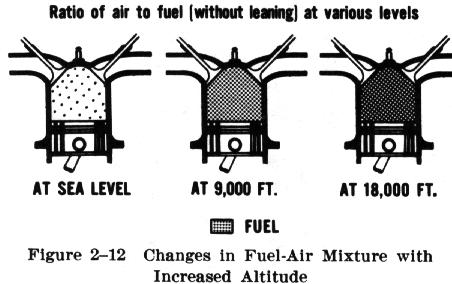Fuel
Fuel/Air Mixture Control
Gasoline will not burn unless it is first mixed with air (oxygen) in
the proper proportion. For the mixture to burn efficiently, the ratio of
fuel to air must be maintained within a specific range. These mixtures
are described either by ratio expression or by decimal figures. Thus, 12
pounds of air and 1 pound of fuel may be described as an air/fuel ration
of 12:1.
Mixtures as rich as 8:1 and as lean as 16:1 will burn in the cylinder
of an engine that develops maximum power with about a 12:1 ratio. Why not
preset this mixture, then, and do away with manual controls? Because as
altitude increases, the air becomes less dense. At 18,000 feet the air
is only half as dense as at sea level; that is, a cubic foot of space contains
only half as many molecules of air (oxygen). Similarly, an engine cylinder
full of air at 18,000 feet contains only half as much oxygen as the same
cylinder full at sea level. Meanwhile, without adjustment, the fuel is
being metered at the same rate (by volume) as at lower altitudes. Consequently,
as the airplane gains altitude at a fixed throttle setting, the cylinders
are getting progressively less oxygen with the same amount of fuel; i.e.,
a richer mixture. As the airplane climbs higher and higher and the fuel/air
mixture becomes richer, the excessive fuel causes the engine to lose power
and to run rougher and rougher (Fig. 2-12). The mixture control, then,
provides a means for the pilot to decrease fuel to compensate for this
imbalance in mixture as altitude increases.
| If the pilot adjusts the engine's fuel mixture precisely
(according to the engine manufacturer's recommendations), there will be
a noticeable saving in fuel for a given flight - with no sacrifice in airspeed.
In fact, under some conditions, there might even be an airspeed gain.
Engines are more efficient when they are supplied with the proper mixture
of fuel and air. Flying with an over rich mixture may induce spark plug
fouling, which may shorten the life of the plugs. Proper leaning also results
in a smoother running engine, and a cleaner combustion chamber with less
likelihood of preignition that sometimes results from accumulated carbon
deposits. |
|
If the engine is equipped with a float type carburetor but no instrument
to show the fuel/air mixture ration, this simple but satisfactory method
of adjusting the mixture may be used. Lean the mixture until the engine
begins to run rough, then enrich the mixture slightly until the engine
runs smooth again. When this method is used with a fixed pitch propeller
at a given throttle setting in level flight, a small increase in engine
RPM (revolutions per minute) and airspeed may be noted at or before the
point of roughness. The mixture then should be enriched to the point of
smoothness, though the RPM may stay the same or it may drop slightly. With
a controllable prop and a fixed throttle setting in level flight, a slight
increase in airspeed only may be noted without the RPM increase noted for
fixed pitch propellers.
Fuel injected engines usually have fuel flow indicators on the instrument
panel. On these engines, adjust the mixture by setting the fuel flow according
to the instructions in the airplane operating handbook or the markings
on the fuel flow indicator itself.
Operating an engine with a too lean mixture can result in serious and
expensive engine damage, although severe damage rarely occurs at normal
cruise power. It is much more apt to occur when operating at high power
settings (above 75% of rated power for most engines) combined with too
lean mixtures which damage the engine due to overheating. Nevertheless,
it has proven harmful to over lean at any power setting (besides, maximum
engine efficiency comes only with the proper fuel mixture). If flying with
higher than normal power settings, it is permissible to lean, but this
needs to be done scientifically. It needs sophisticated instrumentation
and precise adjustments, to avoid engine damage. The following basic rules
are recommended at all times:
1. Always enrich the mixture before increasing
power.
2. Reset the mixture after any change
in power or altitude.
3. Use full rich mixture for takeoff
and climb, unless the manufacturer recommends leaning at high elevations
to eliminate roughness and loss of power.
Some pilots believe that the mixture should never be leaned below 5,000
feet MSL, but this is not necessarily true. Most fuel metering devices
are set on the rich side, which means that prudent leaning is permitted
- in fact advisable - at almost any altitude when the engine is operated
at less than 75% of its rated power. When a 5,000 foot restriction on leaning
is recommended by the manufacturer, it usually is applicable during climbs
when climb power is being used.
